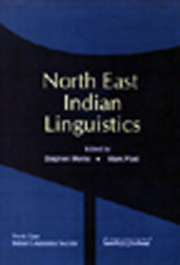Book contents
- Frontmatter
- Contents
- Introduction
- Foreword
- Phonology
- Lexicon
- 5 Lexicon in a Contact Language: The Case of Bishnupriya
- 6 Shafer's ‘parallels’ between Khasi and Sino-Tibetan
- 7 An Exploratory Study of the Terms of Relationship in Khamti of Lohit district in Arunachal Pradesh
- 8 Verbs of Position, Existence, Location and Possession and their Grammaticalization Pathways in the Tani Languages
- Morphology, Syntax, and Semantics
- Language Description and Language Endangerment
8 - Verbs of Position, Existence, Location and Possession and their Grammaticalization Pathways in the Tani Languages
from Lexicon
Published online by Cambridge University Press: 26 October 2011
- Frontmatter
- Contents
- Introduction
- Foreword
- Phonology
- Lexicon
- 5 Lexicon in a Contact Language: The Case of Bishnupriya
- 6 Shafer's ‘parallels’ between Khasi and Sino-Tibetan
- 7 An Exploratory Study of the Terms of Relationship in Khamti of Lohit district in Arunachal Pradesh
- 8 Verbs of Position, Existence, Location and Possession and their Grammaticalization Pathways in the Tani Languages
- Morphology, Syntax, and Semantics
- Language Description and Language Endangerment
Summary
Introduction
In some languages, existential, locative and possessive predications are handled by verbs, verbal auxiliaries or copulas with tailored existential, locative or possessive meanings such as ‘be (at)’, ‘live’, ‘have’ or ‘exist’. In other languages, some or all of these functions may be coded by verbs of posture or orientation such as ‘sit’ ‘stand’ and ‘lie down’, among others (cf. several papers in Newman 2002; also Hellwig 2003). Often, existential, locative or possessive predicate selection in the second type of language depends on, or makes reference to, some inherent properties of the focused referent (i.e., the existee, locatee, or possessed), and/or its orientation in space (i.e., in terms of the speaker's construal of the situation). Aikhenvald (2000: §6.2.3) has described this operation as ‘classificatory’, as it basically reflects the same semantic and pragmatic principles governing selection of numeral or nominal classifiers in languages which have them.
In Tibeto-Burman languages, as discussed in particular by LaPolla (1994), it is common to find two, three, four, or as many as seven ‘existential’ or ‘locative’ verbs, selection of which depends at least in part on some attribute(s) of the referent whose existence, location or possession is under predication, such as animacy/mobility, abstractness or concreteness, or degree of independence or containment, etc.; i.e., they appear to ‘classify’ referents in Aikhenvald's (2000) sense. In the Tani languages 128 North East Indian Linguistics (see Figures 1–2), we find as many as five such verbs; henceforth, I will describe these verbs (for Tani-internal purposes) as special intransitives. My main purpose here will be to provide, to the extent currently possible, an overview of the verbs involved and their functions in different Tani languages.
- Type
- Chapter
- Information
- North East Indian Linguistics , pp. 127 - 150Publisher: Foundation BooksPrint publication year: 2008
- 2
- Cited by

